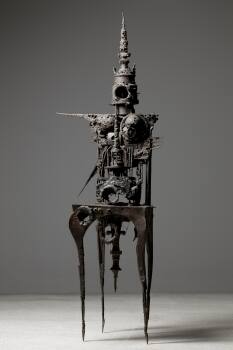The exhibition Alešville is the first comprehensive retrospective of the sculptor Aleš Veselý (1935–2015), one of the key figures of Czech post-war art. Veselý stood out in particular for his monumental works in public spaces, both in the Czech Republic, such as the sculpture Gate to the Irreversible (Prague-Bubny, 2015), and abroad, for instance in the German cities of Bochum (1979) and Hamm (1980). In 1970, he acquired a former mill in Středokluky near Prague, where he built a unique sculpture studio in the form of a complex land-art structure. Despite the repression of the then communist regime, he created a place of freedom there and developed his timeless ideas, making multi-ton sculptures. He placed sculpture models around the site, creating temporary installations and even making music with some of the sculptures. After the Velvet Revolution in 1989, he became a well-respected teacher at the Academy of Fine Arts in Prague. His most recent realisations include The Law of Irreversibility, created in 2015 and placed at the Jewish cemetery in Terezín. In the same year, he died prematurely, leaving behind an unfinished body of work.
The title of the exhibition, Alešville, is based on Vesely’s earlier drawings and reflects the artist’s inner urge to exist in a world of great dimensions. The exhibition in the Great Hall of the Trade Fair Palace will present his gradual transition from human-scale sculptures to monumental endeavours. Previously unknown drawings, prints, and paintings from the 1950s will be complemented by expressive structural paintings and welded objects from the 1960s, such as the famous Usurper Chair (1964) and the seven-metre-high Kaddish sculpture, created in the hall of the Vítkovice Ironworks in Ostrava (1967–1968).
Also on display will be Veselý’s works created in Středokluky, including curved wagons and compasses from wood and iron, as well as international commissions from the 1970s and 1980s. The exhibition also features drawings and models of unrealised projects intended for the desert, on which Veselý focused intensively from the 1990s on – Between Heaven and Earth, Kadesh Barnea Monument and Mountains of Mountains – as well as of his existing international works (in the Netherlands, Lithuania, etc.).
Introductory artwork on the page: Aleš Veselý, Enigma of the Circle, 1965
Venue: Great Hall of the Trade Fair Palace
Also on display will be Veselý’s works created in Středokluky, including curved wagons and compasses from wood and iron, as well as international commissions from the 1970s and 1980s. The exhibition also features drawings and models of unrealised projects intended for the desert, on which Veselý focused intensively from the 1990s on – Between Heaven and Earth, Kadesh Barnea Monument and Mountains of Mountains – as well as of his existing international works (in the Netherlands, Lithuania, etc.).
Introductory artwork on the page: Aleš Veselý, Enigma of the Circle, 1965
Venue: Great Hall of the Trade Fair Palace
1—1 / 3









